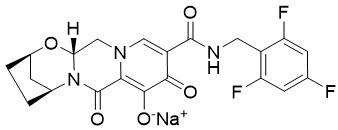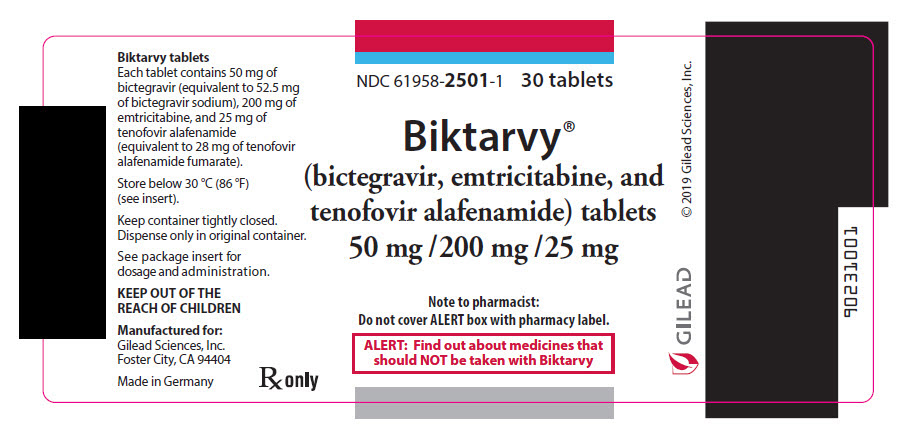Biktarvy
Generic name: bictegravir, emtricitabine, and tenofovir
Drug class: Antiviral combinations
Medically reviewed by A Ras MD.
What is Biktarvy?
Biktarvy is a prescription medicine that is used without other anti-HIV-1 medicines to treat Human Immunodeficiency Virus-1 (HIV-1) in adults and children who weigh at least 55 pounds (25 kg) who have not received anti-HIV-1 medicines in the past, or to replace their current anti-HIV-1 medicines for people whose healthcare provider determines that they meet certain requirements.
HIV-1 is the virus that causes Acquired Immune Deficiency Syndrome (AIDS).
Biktarvy contains the medicines bictegravir, emtricitabine, and tenofovir alafenamide.
It is not known if Biktarvy is safe and effective in children who weigh less than 55 pounds (25 kg).
Description
BIKTARVY (bictegravir, emtricitabine, and tenofovir alafenamide) is a fixed dose combination tablet containing bictegravir (BIC), emtricitabine (FTC), and tenofovir alafenamide (TAF) for oral administration.
- BIC is an integrase strand transfer inhibitor (INSTI).
- FTC, a synthetic nucleoside analog of cytidine, is an HIV nucleoside analog reverse transcriptase inhibitor (HIV NRTI).
- TAF, an HIV NRTI, is converted in vivo to tenofovir, an acyclic nucleoside phosphonate (nucleotide) analog of adenosine 5′-monophosphate.
BIKTARVY tablets are available in two dose strengths:
- 50 mg/200 mg/25 mg tablet containing 50 mg of BIC (equivalent to 52.5 mg of bictegravir sodium),
200 mg of FTC, and 25 mg of TAF (equivalent to 28 mg of tenofovir alafenamide fumarate). - 30 mg/120 mg/15 mg tablet containing 30 mg of BIC (equivalent to 31.5 mg of bictegravir sodium), 120 mg of FTC, and 15 mg of TAF (equivalent to 16.8 mg of tenofovir alafenamide fumarate).
Both dose strengths of BIKTARVY tablets include the following inactive ingredients: croscarmellose sodium, magnesium stearate, and microcrystalline cellulose. The tablets for both dose strengths are film-coated with a coating material containing iron oxide black, iron oxide red, polyethylene glycol, polyvinyl alcohol, talc, and titanium dioxide.
Bictegravir: The chemical name of bictegravir sodium is 2,5-Methanopyrido[1′,2′:4,5]pyrazino[2,1-b][1,3]oxazepine-10-carboxamide, 2,3,4,5,7,9,13,13a-octahydro-8-hydroxy-7,9-dioxo-N-[(2,4,6-trifluorophenyl)methyl]-, sodium salt (1:1), (2R,5S,13aR)-.
Bictegravir sodium has a molecular formula of C21H17F3N3NaO5 and a molecular weight of 471.4 and has the following structural formula:

Bictegravir sodium is an off-white to yellow solid with a solubility of 0.1 mg per mL in water at 20 °C.
Emtricitabine: The chemical name of FTC is 4-amino-5-fluoro-1-(2R-hydroxymethyl-1,3-oxathiolan-5S-yl)-(1H)-pyrimidin-2-one. FTC is the (-)enantiomer of a thio analog of cytidine, which differs from other cytidine analogs in that it has a fluorine in the 5 position.
FTC has a molecular formula of C8H10FN3O3S and a molecular weight of 247.2 and has the following structural formula:

FTC is a white to off-white powder with a solubility of approximately 112 mg per mL in water at 25 °C.
Tenofovir alafenamide: The chemical name of tenofovir alafenamide fumarate drug substance is L-alanine, N-[(S)-[[(1R)-2-(6-amino-9H-purin-9-yl)-1-methylethoxy]methyl]phenoxyphosphinyl]-, 1-methylethyl ester, (2E)-2-butenedioate (2:1).
Tenofovir alafenamide fumarate has an empirical formula of C21H29O5N6P∙½(C4H4O4) and a formula weight of 534.5 and has the following structural formula:

Tenofovir alafenamide fumarate is a white to off-white or tan powder with a solubility of 4.7 mg per mL in water at 20 °C.
What is the most important information I should know about Biktarvy?
Important: Ask your healthcare provider or pharmacist about medicines that should not be taken with Biktarvy. For more information, see “What should I tell my healthcare provider before taking Biktarvy?”
Biktarvy can cause serious side effects, including:
- Worsening of Hepatitis B virus infection. If you have hepatitis B virus (HBV) infection and take Biktarvy, your HBV may get worse (flare-up) if you stop taking Biktarvy. A “flare-up” is when your HBV infection suddenly returns in a worse way than before.
- Do not run out of Biktarvy. Refill your prescription or talk to your healthcare provider before your Biktarvy is all gone.
- Do not stop taking Biktarvy without first talking to your healthcare provider.
- If you stop taking Biktarvy, your healthcare provider will need to check your health often and do blood tests regularly for several months to check your HBV infection. Tell your healthcare provider about any new or unusual symptoms you may have after you stop taking Biktarvy.
For more information about side effects, see “What are the possible side effects of Biktarvy?”
Who should not take Biktarvy?
Do not take Biktarvy if you also take a medicine that contains:
- dofetilide
- rifampin
What should I tell my healthcare provider before taking Biktarvy?
Before taking Biktarvy, tell your healthcare provider about all your medical conditions, including if you:
- have liver problems, including hepatitis B virus infection
- have kidney problems
- are pregnant or plan to become pregnant. It is not known if Biktarvy can harm your unborn baby. Tell your healthcare provider if you become pregnant during treatment with Biktarvy.
- Pregnancy Registry: There is a pregnancy registry for women who take Biktarvy during pregnancy. The purpose of this registry is to collect information about the health of you and your baby. Talk with your healthcare provider about how you can take part in this registry.
- are breastfeeding or plan to breastfeed. Do not breastfeed if you take Biktarvy. Talk with your healthcare provider about the best way to feed your baby.
- You should not breastfeed if you have HIV-1 because of the risk of passing HIV-1 to your baby.
- At least one of the medicines in Biktarvy can pass to your baby in your breast milk. It is not known if the other medicines in Biktarvy can pass into your breast milk.
Tell your healthcare provider about all the medicines you take, including prescription and over-the-counter medicines, antacids, laxatives, vitamins, and herbal supplements.
Some medicines may interact with Biktarvy. Keep a list of your medicines and show it to your healthcare provider and pharmacist when you get a new medicine.
- You can ask your healthcare provider or pharmacist for a list of medicines that interact with Biktarvy.
- Do not start a new medicine without telling your healthcare provider. Your healthcare provider can tell you if it is safe to take Biktarvy with other medicines.
How should I take Biktarvy?
- Take Biktarvy exactly as your healthcare provider tells you to take it. Biktarvy is taken by itself (not with other HIV-1 medicines) to treat HIV-1 infection.
- Take Biktarvy 1 time each day with or without food.
- Do not change your dose or stop taking Biktarvy without first talking with your healthcare provider. Stay under a healthcare provider’s care during treatment with Biktarvy.
- If you take antacids that contain aluminum or magnesium, take Biktarvy at least 2 hours before or 6 hours after you take these antacids.
- If you take supplements or antacids that contain iron or calcium, take Biktarvy with food at the same time that you take these supplements or antacids.
- Do not miss a dose of Biktarvy.
- If you take too much Biktarvy, call your healthcare provider or go to the nearest hospital emergency room right away.
- When your Biktarvy supply starts to run low, get more from your healthcare provider or pharmacy. This is very important because the amount of virus in your blood may increase if the medicine is stopped for even a short time. The virus may develop resistance to Biktarvy and become harder to treat.
What are the possible side effects of Biktarvy?
Biktarvy may cause serious side effects, including:
- See “What is the most important information i should know about Biktarvy?”
- Changes in your immune system (Immune Reconstitution Syndrome) can happen when you start taking HIV-1 medicines. Your immune system may get stronger and begin to fight infections that have been hidden in your body for a long time. Tell your healthcare provider right away if you start having any new symptoms after starting your HIV-1 medicine.
- New or worse kidney problems, including kidney failure. Your healthcare provider should do blood and urine tests to check your kidneys when starting and during treatment with Biktarvy. Your healthcare provider may tell you to stop taking Biktarvy if you develop new or worse kidney problems.
- Too much lactic acid in your blood (lactic acidosis). Too much lactic acid is a serious but rare medical emergency that can lead to death. Tell your healthcare provider right away if you get these symptoms: weakness or being more tired than usual, unusual muscle pain, being short of breath or fast breathing, stomach pain with nausea and vomiting, cold or blue hands and feet, feel dizzy or lightheaded, or a fast or abnormal heartbeat.
- Severe liver problems. In rare cases, severe liver problems can happen that can lead to death. Tell your healthcare provider right away if you get these symptoms: skin or the white part of your eyes turns yellow, dark “tea-colored” urine, light-colored stools, loss of appetite for several days or longer, nausea, or stomach-area pain.
The most common side effects of Biktarvy are diarrhea, nausea, and headache.
These are not all the possible side effects of Biktarvy.
Call your doctor for medical advice about side effects. You may report side effects to FDA at 1-800-FDA-1088.
General information about the safe and effective use of Biktarvy.
Medicines are sometimes prescribed for purposes other than those listed in a Patient Information leaflet. Do not use Biktarvy for a condition for which it was not prescribed. Do not give Biktarvy to other people, even if they have the same symptoms you have. It may harm them. If you would like more information, talk with your healthcare provider. You can ask your healthcare provider or pharmacist for information about Biktarvy that is written for health professionals.
For more information, call 1-800-445-3235 or go to www.Biktarvy.com.
How should I store Biktarvy?
- Store Biktarvy below 86°F (30°C).
- Keep Biktarvy in its original container.
- Keep the container tightly closed.
Keep Biktarvy and all medicines out of reach of children.
What are the ingredients in Biktarvy?
Active ingredients: bictegravir, emtricitabine, and tenofovir alafenamide.
Inactive ingredients: croscarmellose sodium, magnesium stearate, and microcrystalline cellulose.
The tablets are film-coated with a coating material containing iron oxide black, iron oxide red, polyethylene glycol, polyvinyl alcohol, talc, and titanium dioxide.
Label
PRINCIPAL DISPLAY PANEL – 50 MG/200 MG/25 MG TABLET BOTTLE LABEL
- NDC 61958-2501-130 tablets
- Biktarvy ®(bictegravir, emtricitabine, and
tenofovir alafenamide) tablets
50 mg /200 mg /25 mg
- Note to pharmacist:Do not cover ALERT box with pharmacy label.
- ALERT: Find out about medicines thatshould NOT be taken with Biktarvy

PRINCIPAL DISPLAY PANEL – 30 MG/120 MG/15 MG TABLET BOTTLE LABEL
- NDC 61958-2505-1
30 tablets - Biktarvy®
(bictegravir, emtricitabine,
and tenofovir alafenamide)
tablets
30 mg / 120 mg / 15 mg - Note to pharmacist:
Do not cover ALERT box with pharmacy label. - ALERT: Find out about medicines that
should NOT be taken with Biktarvy

SRC: NLM .
